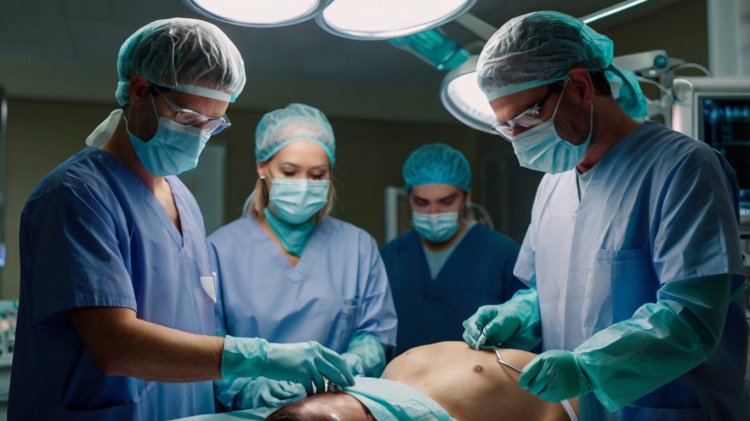Medical Procedures for Cystic Fibrosis: Managing Symptoms and Improving Quality of Life
Cystic fibrosis is a complex genetic condition that often requires specialized medical procedures to manage symptoms and improve quality of life. This guide provides an in-depth look at key procedures commonly used in the treatment of cystic fibrosis, including endoscopy for airway management, sinus surgery to address chronic sinus infections, the use of feeding tubes to maintain proper nutrition, and organ transplants for advanced cases involving the lungs or liver. You'll discover how each of these treatments plays a vital role in managing the disease, alleviating symptoms, and enhancing overall health

Cystic fibrosis (CF) is a genetic condition that affects multiple organs, leading to complications in the lungs, digestive system, and liver. To manage the symptoms and improve the quality of life, individuals with CF often require various medical procedures. This comprehensive guide explores these procedures, their purposes, and how they contribute to better outcomes for those living with CF.
Common Medical Procedures for Cystic Fibrosis
1. Endoscopy and Lavage
What It Is
Endoscopy involves using a flexible tube with a camera to visualize internal organs. Lavage refers to washing out body cavities to remove mucus or debris.
Uses in CF
-
Nasal and Sinus Evaluation: Detects inflammation, blockages, or infections in the nasal passages and sinuses.
-
Bronchoscopy: Examines the airways and lungs, collects samples, removes mucus plugs, and assesses lung health.
Types of Lavage
-
Sinus Lavage: Flushes thick mucus from the sinuses to alleviate congestion and prevent infections.
-
Bronchoalveolar Lavage (BAL): Introduces saline into the airways to collect samples and remove mucus, reducing infection risks and improving breathing.
2. Nasal and Sinus Surgery
Purpose
Endoscopic sinus surgery (ESS) treats chronic sinus infections and nasal blockages, which are common in CF due to thick mucus buildup.
Benefits
-
Clears blocked sinuses and removes polyps.
-
Improves drainage, relieving congestion and sinus pain.
-
Enhances lung function by reducing infections caused by sinus issues.
Evidence of Effectiveness
A 2021 study showed significant symptom improvement after ESS in people with CF, although outcomes were less pronounced in individuals with certain bacterial infections, like pseudomonas.
3. Feeding Tube Insertion
Why It’s Needed
People with CF often struggle with reduced appetite, malabsorption, and increased energy demands due to lung infections. A feeding tube helps meet nutritional needs.
Types of Feeding Tubes
-
Nasogastric Tube: Inserted through the nose into the stomach.
-
Gastrostomy Tube: Surgically placed directly into the stomach.
Benefits
-
Increases body weight and improves BMI.
-
Enhances lung function and reduces infections.
-
Supports growth and physical activity.
4. Bowel Surgery
Purpose
Addresses complications in the digestive system caused by thick mucus and malabsorption.
Common Reasons for Surgery
-
Distal Intestinal Obstruction Syndrome (DIOS): Caused by mucus and undigested food blocking the intestines.
-
Meconium Ileus: A bowel obstruction in newborns with CF.
-
Severe GERD: Surgery may be necessary for gastroesophageal reflux disease that does not respond to other treatments.
Effectiveness
A 2022 study found that intestinal obstruction is a leading reason for bowel surgery in adults with CF, and anti-reflux surgery improved symptoms and lung function in many cases.
5. Lung Transplant
When It’s Needed
Lung transplants are considered when CF progresses to advanced stages, leading to significant scarring, infections, and loss of lung function.
Key Facts
-
About 17% of lung transplants globally are performed on people with CF.
-
Transplants should occur before end-stage lung disease to optimize outcomes.
Post-Transplant Benefits
-
Improved breathing and quality of life.
-
Extended life expectancy in advanced CF cases.
6. Liver Transplant
Purpose
CF can impair bile flow, leading to liver scarring (cirrhosis) and complications like portal hypertension.
When It’s Recommended
-
Significant liver damage or failure.
-
Life-threatening complications such as variceal bleeding.
Prevalence
Liver disease affects 5% to 10% of people with CF, making liver transplants a critical intervention for severe cases.
The Importance of Early and Ongoing Treatment
Managing CF requires a proactive and multidisciplinary approach. Early diagnosis and intervention help slow disease progression and improve overall outcomes. Advances in medical care, including these procedures, are significantly increasing the life expectancy and quality of life for individuals with CF.
Frequently Asked Questions
1. How does a lung transplant improve life for people with CF?
A lung transplant replaces damaged lungs with healthy ones, improving breathing, reducing infections, and extending life expectancy.
2. Are feeding tubes permanent in CF treatment?
Not always. Feeding tubes may be temporary or long-term, depending on the individual’s nutritional needs and overall health.
3. Can sinus surgery cure sinus infections in CF?
While sinus surgery helps reduce infections and improve symptoms, it’s not a cure. Regular follow-up care is needed to maintain results.
4. What are the risks of bowel surgery in CF?
Risks include infections, complications from anesthesia, and potential recurrence of obstruction. However, these risks are outweighed by the benefits in severe cases.
5. How common is liver disease in CF?
Liver disease occurs in 5% to 10% of individuals with CF and is typically seen around the ages of 10 to 11.
Conclusion
Cystic fibrosis is a complex condition that affects multiple organ systems, requiring various medical procedures to manage symptoms and complications. From endoscopy and sinus surgery to lung and liver transplants, these interventions are vital for improving health and quality of life. Advances in medical care continue to provide hope and better outcomes for those living with CF








